ADC Telecommunications DLCSMR2A Digivance SMR 20 Watt System User Manual 75159
ADC Telecommunications Inc Digivance SMR 20 Watt System 75159
Contents
manual 2
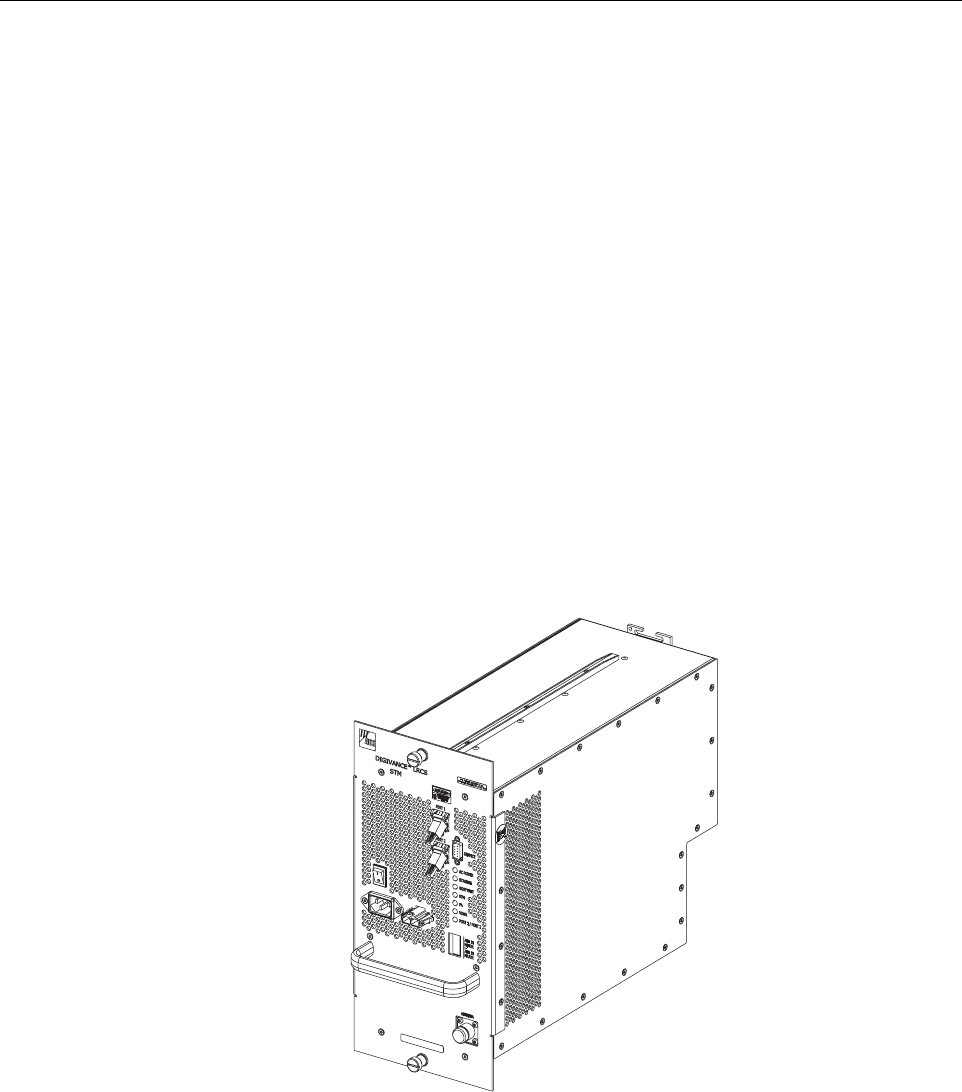
ADCP-75-159 • Issue 1 • August 2003 • Section 2: Description
Page 2-16
© 2003, ADC Telecommunications, Inc.
• Digitizes the reverse path composite RF signal.
• Converts the digitized reverse path RF signal to a digitized optical signal.
• Provides an RS-232 interface for connecting a local EMS computer.
• Transports alarm, control, and monitoring information to the HU via the optical link.
• Provides an AC power interface.
• Provides an external alarm interface.
5.1 Primary Components
The STM consists of an electronic circuit board assembly, power supply, duplexer, and fan
assembly that are mounted within an anodized and powder-paint coated sheet metal enclosure.
The metal enclosure provides a mounting point for the electronic components and also controls
RF emissions. Except for the fan unit, the electronic components are not user replaceable. The
STM is designed for use within the RU outdoor cabinet or indoor mounting shelf. Except for the
LPA interface connector, all controls, connectors, indicators, and switches are mounted on the
STM front panel for easy access. A carrying handle is provided on the front of the STM to
facilitate installation and transport.
Figure 2-7. Spectrum Transport Module
5.2 Mounting
The STM mounts within the RU outdoor cabinet or indoor mounting shelf. Runners on the top
and bottom of the STM mesh with tracks. The runners and tracks guide the STM into the
installed position. The electrical interface between the STM and LPA is supported by a D-sub
18634-B
FCC ID: F8I-DLCSMR2A User Manual - Part 2

ADCP-75-159 • Issue 1 • August 2003 • Section 2: Description
Page 2-17
© 2003, ADC Telecommunications, Inc.
female connector located on the rear side of the STM. A corresponding D-sub male connector
mounted at the rear of the RU cabinet or RU mounting shelf mates with the STM connector.
Captive screws are provided for securing the STM in the installed position.
5.3 Fault Detection and Alarm Reporting
The STM detects and reports various faults including remote unit fault, optical fault, power
fault, temperature fault, power amplifier fault, and external (door open) fault. Various front
panel Light Emitting Diode (LED) indicators turn from green to red or yellow if a fault is
detected. The status of the STM, the alarm state (major or minor), and other alarm information
is summarized and reported over the optical interface to the HU and also over the service
interface. In addition, the alarm state of the HU is received over the optical interface and
reported to the service interface. This information may be accessed remotely through the NOC/
NEM interface or locally through the EMS software GUI.
5.4 Antenna Cable Connection
The antenna cable connections between the STM and the antenna are supported through one N-
type female connector which carries both the forward and reverse path RF signals. When
installed in the RU outdoor cabinet, the STM does not connect directly to the antenna but
instead connects to a lightning protector that is mounted on the bottom of the cabinet (see
Section 3.6). A coaxial jumper cable is provided (included with the enclosure) for connecting
the STM to the lightning protector.
5.5 RF Signal Level Adjustment
The STM is equipped with a digital attenuator for adjusting the signal level of the forward path
RF output signal. The remote forward path attenuator adjusts the level of the output RF signal
at the RU antenna port and will add from 0 to 20 dB of attenuation to the output signal level.
The attenuator can be set in 1 dB increments. The attenuator is software controlled and is
adjusted through the NOC/NEM interface or the EMS software GUI.
5.6 Optical Connection
Fiber optic connections between the STM and the HU are supported through two SC-type
optical connector ports. One port is used for connecting the forward path optical signal and the
other port is used for connecting the primary reverse path optical signal.
5.7 Service Interface Connection
The service interface connection between the STM and a local laptop computer loaded with the
EMS software is supported by a single DB-9 female connector. The service interface connector
provides an RS-232 DTE interface. The STM service interface connector supports local
communications with both the STM and the corresponding HU.

ADCP-75-159 • Issue 1 • August 2003 • Section 2: Description
Page 2-18
© 2003, ADC Telecommunications, Inc.
5.8 Powering
The STM is powered by 120 or 240 VAC (50 or 60 Hz) power which is supplied through a
three-conductor AC power cord. The power cord is provided with the RU outdoor cabinet or
indoor mounting shelf. The power cord connects to an AC connector mounted on the STM front
panel. A switch on the STM front panel provides AC power On/Off control.
5.9 Cooling
Continuous air-flow for cooling is provided by a single fan mounted on the rear side of the STM
housing. An alarm is provided that indicates if a high temperature condition (>50º C/122º F)
occurs. If the temperature falls below 32º F (0º C), the fan automatically shuts off. The fan may
be field replaced if it fails.
5.10 User Interface
The STM user interface consists of the various connectors, switches, and LEDs that are
provided on the STM front panel. The STM user interface points are described in Table 2-4 and
shown in Figure 2-8.
Table 2-4. Spectrum Transport Module User Interface
REF
NO
USER INTERFACE
DESIGNATION DEVICE FUNCTIONAL
DESCRIPTION
1 PORT 1 SC connector
(single-mode) Input connection point for the forward path opti-
cal fiber.
2 PORT 2 SC connector
(single-mode) Output connection point for the reverse path pri-
mary optical fiber.
3I/0 On/Off rocker
switch Provides AC power on/off control.
4 No designation 3-wire AC power
cord connector Connection point for the AC power cord.
5 No designation 2- wire DC power
cord connector Connection point for a back-up battery power
cord. (Not used with 20 Watt system)
6 SERVICE DB-9 connector
(female) Connection point for the RS-232 service inter-
face cable.
7 AC POWER Multi-colored LED
(green/red)
Indicates if the STM is powered by the AC power
source (green) or the back-up battery system
(red). See Note.
8 STANDBY Multi-colored LED
(green/yellow/red)
Indicates if the system is in the Normal state (off)
Standby state (blinking green), Test state (blink-
ing red), or Program Load state (blinking yel-
low). See Note.
9 HOST UNIT Multi-colored LED
(green/yellow/red)
Indicates if no alarm (green), a minor alarm (yel-
low), or a major alarm (red) is reported by the
HU. See Note.
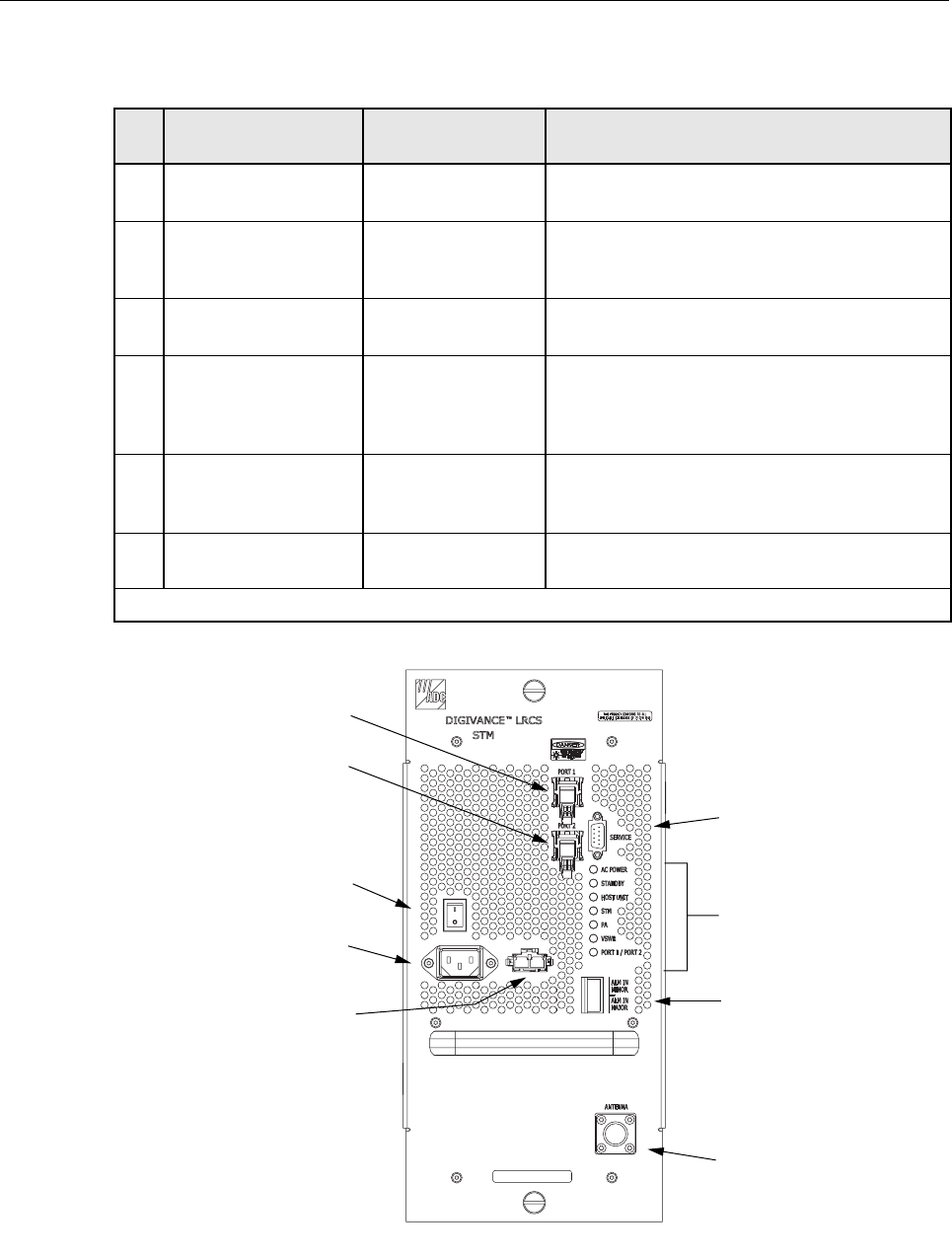
ADCP-75-159 • Issue 1 • August 2003 • Section 2: Description
Page 2-19
© 2003, ADC Telecommunications, Inc.
Figure 2-8. Spectrum Transport Module User Interface
10 STM Multi-colored LED
(green/yellow/red)
Indicates if the STM is normal (green) or faulty
(red). See Note.
11 PA Multi-colored LED
(green/yellow/red)
Indicates if the power amplifier is normal
(green), over temperature (yellow), has a fan fail-
ure (yellow), or is faulty (red). See Note.
12 VSWR Multi-colored LED
(green/yellow/red)
Indicates if the forward path VSWR is above
(red) or below (green) the fault threshold.
13 PORT 1/PORT 2 Multi-colored LED
(green/yellow/red)
Indicates if the forward/reverse path optical sig-
nals from the STM/HU are normal (green), if no
optical signals are detected (red), or if excessive
errors are detected (red). See Note.
14 ALARM IN MINOR
ALARM IN MAJOR
Screw-type terminal
connector (14–26
AWG)
Connection point for two external alarm inputs.
The door-open switch lead wires are typically
connected to the major alarm terminals.
15 ANTENNA N-type female RF
coaxial connector Connection point for the antenna.
Note: A more detailed description of LED operation is provided in Section 5.
Table 2-4. Spectrum Transport Module User Interface, continued
REF
NO
USER INTERFACE
DESIGNATION DEVICE FUNCTIONAL
DESCRIPTION
18636-B
(3) ON/OFF
SWITCH
(4) AC POWER
CONNECTOR
(5) DC POWER
CONNECTOR
(1) PORT 1
CONNECTOR
(2) PORT 2
CONNECTOR
(6) SERVICE
CONNECTOR
(7-13) LED
INDICATORS
(14) ALARM
CONNECTOR
(15) ANTENNA
CONNECTOR
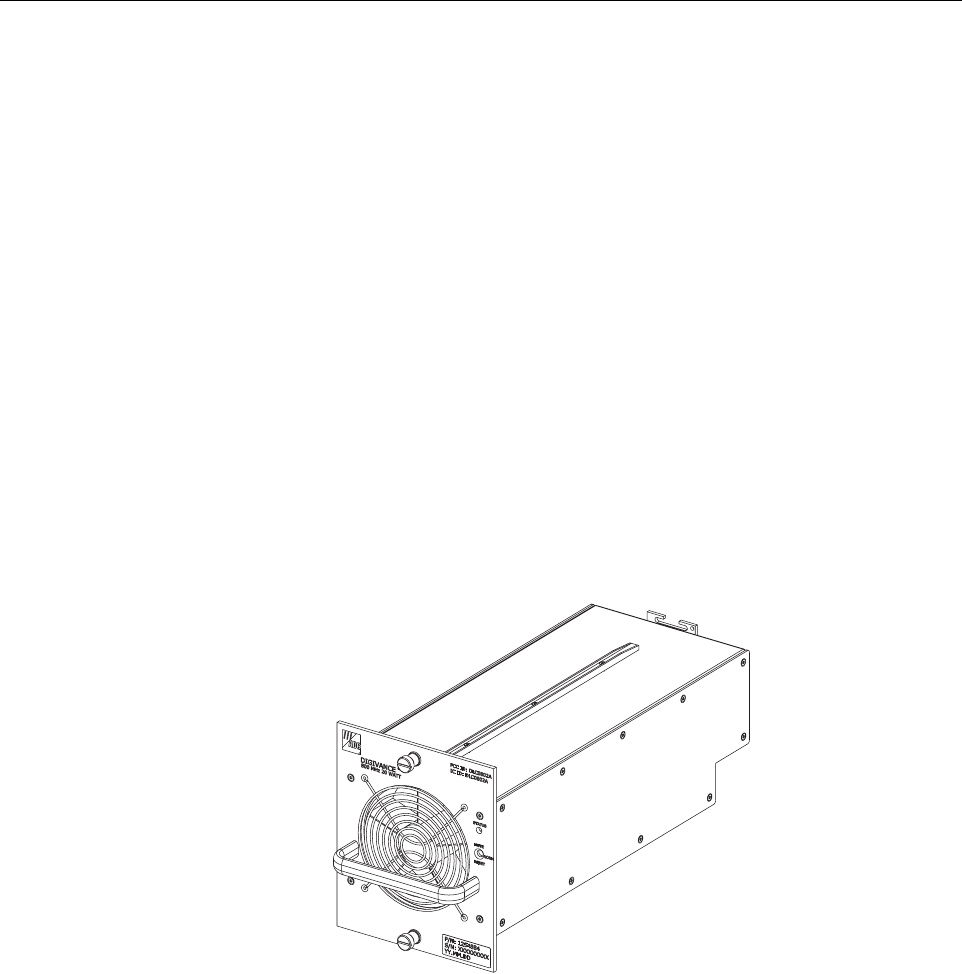
ADCP-75-159 • Issue 1 • August 2003 • Section 2: Description
Page 2-20
© 2003, ADC Telecommunications, Inc.
6 LINEAR POWER AMPLIFIER
The Linear Power Amplifier (LPA), shown in Figure 2-9, works in conjunction with the STM to
amplify the forward path RF output signal. The STM is interfaced with the LPA through the
D-sub connectors and wiring harness located at the rear of the RU cabinet or RU mounting
shelf. The RF signal is passed to the LPA for amplification and then passed back to the STM for
filtering and output via the STM’s ANTENNA port. The STM also supplies DC power to the
LPA through the same interface.
6.1 Primary Components
The LPA consists of a fan and several electronic circuit board assemblies that are mounted
within a powder-paint coated sheet metal enclosure. The metal enclosure provides a mounting
point for the electronic components and also controls RF emissions. Except for the fan unit, the
electronic components are not user replaceable. The LPA is designed for use within the RU
outdoor cabinet or RU indoor mounting shelf. Except for the STM interface connector, all
controls, indicators, and switches are mounted on the LPA front panel for easy access. A
carrying handle is provided on the front of the LPA to facilitate installation and transport.
Figure 2-9. Linear Power Amplifier
6.2 Mounting
The LPA mounts within the RU outdoor cabinet or RU indoor mounting shelf. Runners on the
top and bottom of the LPA mesh with tracks. The runners and tracks guide the LPA into the
installed position. The electrical interface between the STM and LPA is supported by a D-sub
female connector located on the rear side of the LPA. A corresponding D-sub male connector
mounted at the rear of the RU outdoor cabinet or RU indoor mounting shelf mates with the LPA
connector. Captive screws are provided for securing the LPA in the installed position.
18764-A

ADCP-75-159 • Issue 1 • August 2003 • Section 2: Description
Page 2-21
© 2003, ADC Telecommunications, Inc.
6.3 Fault Detection and Alarm Reporting
The LPA in conjunction with the STM detects and reports various faults including power
amplifier fault, output power fault, temperature fault, and fan fault. A single Light Emitting
Diode (LED) indicator, located on the front panel of the LPA, turns from green to red or yellow
if an LPA fault is detected. The status of the LPA, the alarm state (major or minor), and other
information is summarized and reported (by the STM) over the optical fiber to the HU and also
to the service interface. This information may be accessed remotely through the NOC/NEM
interface or locally through the EMS software GUI.
6.4 Powering
The LPA is powered by various DC voltages which are supplied by the STM over the electrical
interface provided by the D-sub connectors and wiring harness mounted within the RU outdoor
cabinet or RU indoor mounting shelf.
6.5 Cooling
Continuous air-flow for cooling is provided by a fan mounted at the front of the LPA housing.
Cool air is pulled into the module from the front and heated air is exhausted out the back. An
alarm is provided that indicates if a high temperature condition (>50º C/122º F) occurs or if a
fan failure occurs. The fan may be field replaced if it fails.
6.6 User Interface
The LPA user interface consists of an LED indicator and a switch that are mounted on the LPA
front panel. The LPA user interface points are described in Table 2-5 and indicated in
Figure 2-10.
Table 2-5. Linear Power Amplifier User Interface
REF
NO
USER INTERFACE
DESIGNATION DEVICE FUNCTIONAL
DESCRIPTION
1 STATUS LED indicator
(green, yellow, and
red)
Indicates the operational state of the LPA and
whether or not there are any faults.
2MUTE
NORM
RESET
3-position switch
with one momentary
contact position
Placing the switch in the MUTE position puts the
LPA in the shutdown state with RF output disabled.
With the switch in MUTE, the STM can not control
the LPA output power. Placing the switch in the
NORM position puts the LPA in the normal state
and allows the STM to enable and disable the RF
output. Momentarily placing the switch in the
RESET position clears all alarms and restarts the
LPA.
Note: A more detailed description of the STATUS LED is provided in Section 5.
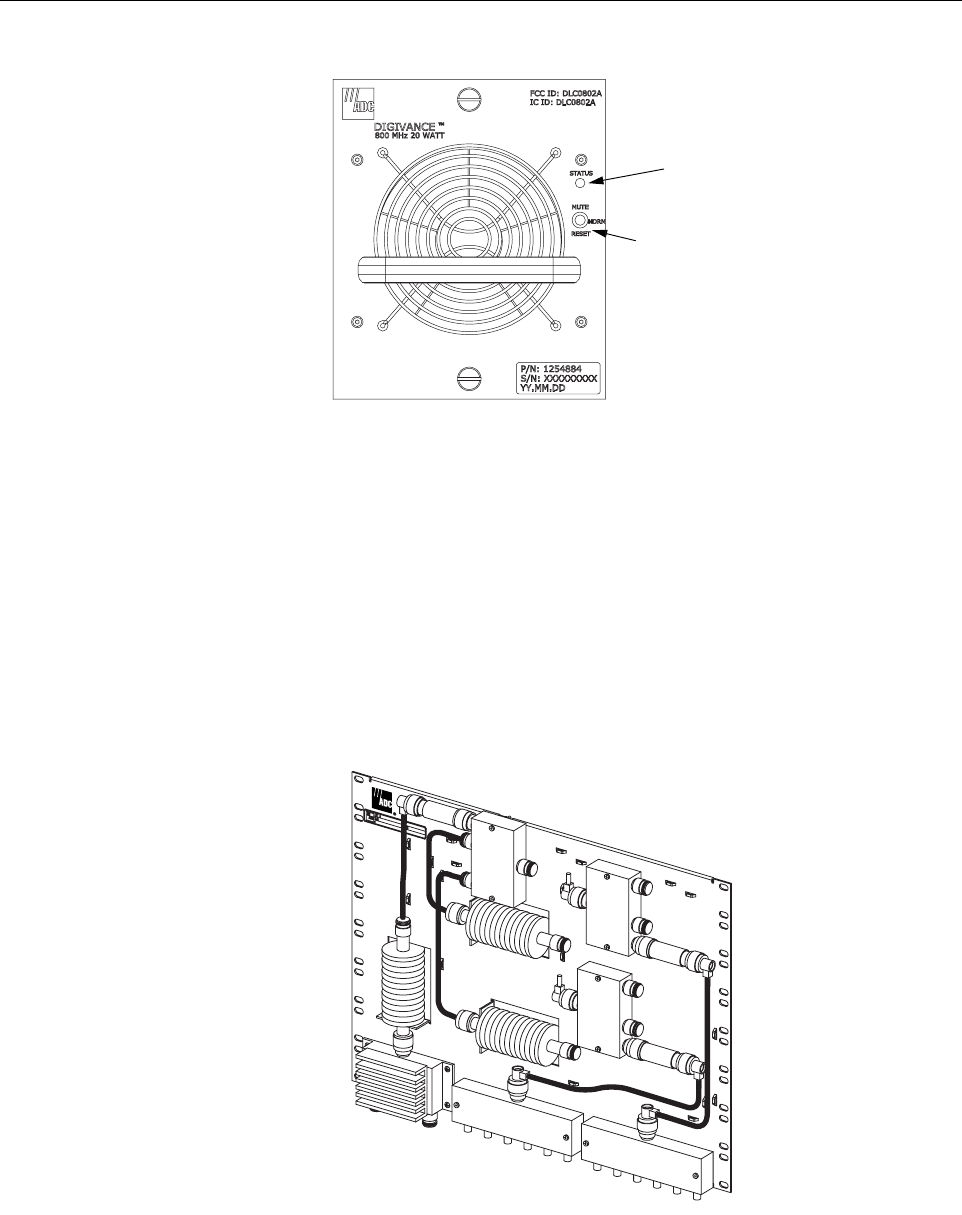
ADCP-75-159 • Issue 1 • August 2003 • Section 2: Description
Page 2-22
© 2003, ADC Telecommunications, Inc.
Figure 2-10. Linear Power Amplifier User Interface
7 INTERFACE PANELS (ACCESSORY)
The interface panels are accessory items that are used when multiple EBTS’s require connection
to a single EBTS. Two types of panels are available: the Primary Interface Panel and the
Expansion Panel. The Primary Interface Panel, shown in Figure 2-11, provides combining and
splitting (as needed) of the forward and reverse path RF signal. The Primary Interface Panel also
provides attenuation of the forward path signal to the level required for input to the HU. Up to 6
EBTS’s may be be connected to a single HU using the Primary Interface Panel.
Figure 2-11. Primary Interface Panel
18765-A
(1) STATUS
(2) MUTE/NORM/
RESET SWITCH
18221-A
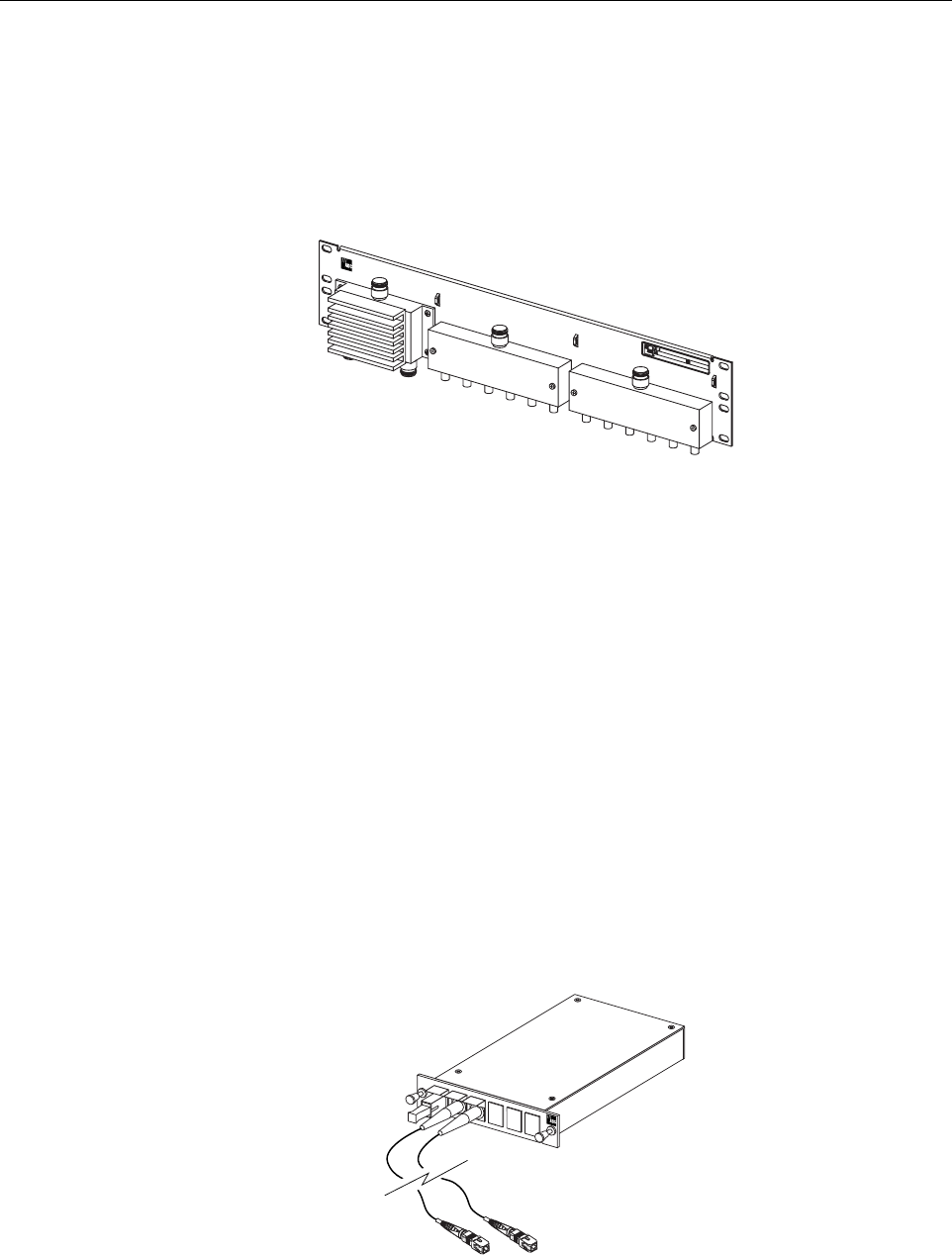
ADCP-75-159 • Issue 1 • August 2003 • Section 2: Description
Page 2-23
© 2003, ADC Telecommunications, Inc.
The Expansion Panel, shown in Figure 2-12, is used in conjunction with the Primary Interface
Panel when more than 6 EBTS’s must be connected to a single HU. The Primary Interface Panel
can support two Expansion Panels and each Expansion Panel can support up to six EBTS’s. For
complete information about the SMR Interface Panels, refer to the Digivance Long Range
Coverage Solution SMR Interface Panels User Manual (ADCP-75-143).
Figure 2-12. Expansion Panel
8 WAVELENGTH DIVISION MULTIPLEXER SYSTEM (ACCESSORY)
The Wavelength Division Multiplexer (WDM) system is an accessory product that is used when
it is desirable or necessary to combine the forward and reverse path optical signals from one
Digivance system onto a single optical fiber. Each WDM system consists of a host module and a
remote module. The HU provides a mounting slot for installing a WDM host module. Both the
RU outdoor cabinet the RU indoor mounting shelf provide a mounting slot for installing a
WDM remote module.
Each WDM module consists of a bi-directional wavelength division multiplexer mounted
within a power-paint coated sheet metal enclosure. A straight SC-type optical connector port is
provided for connecting the forward/reverse path optical fiber to the WDM module. A pair of
pigtail leads with SC-type connectors are provided for connecting the WDM module to the
forward and reverse path optical ports on the HU or STM. The WDM host/remote module is
shown in Figure 2-13.
Figure 2-13. WDM Host/Remote Module
18824-A
17013-A
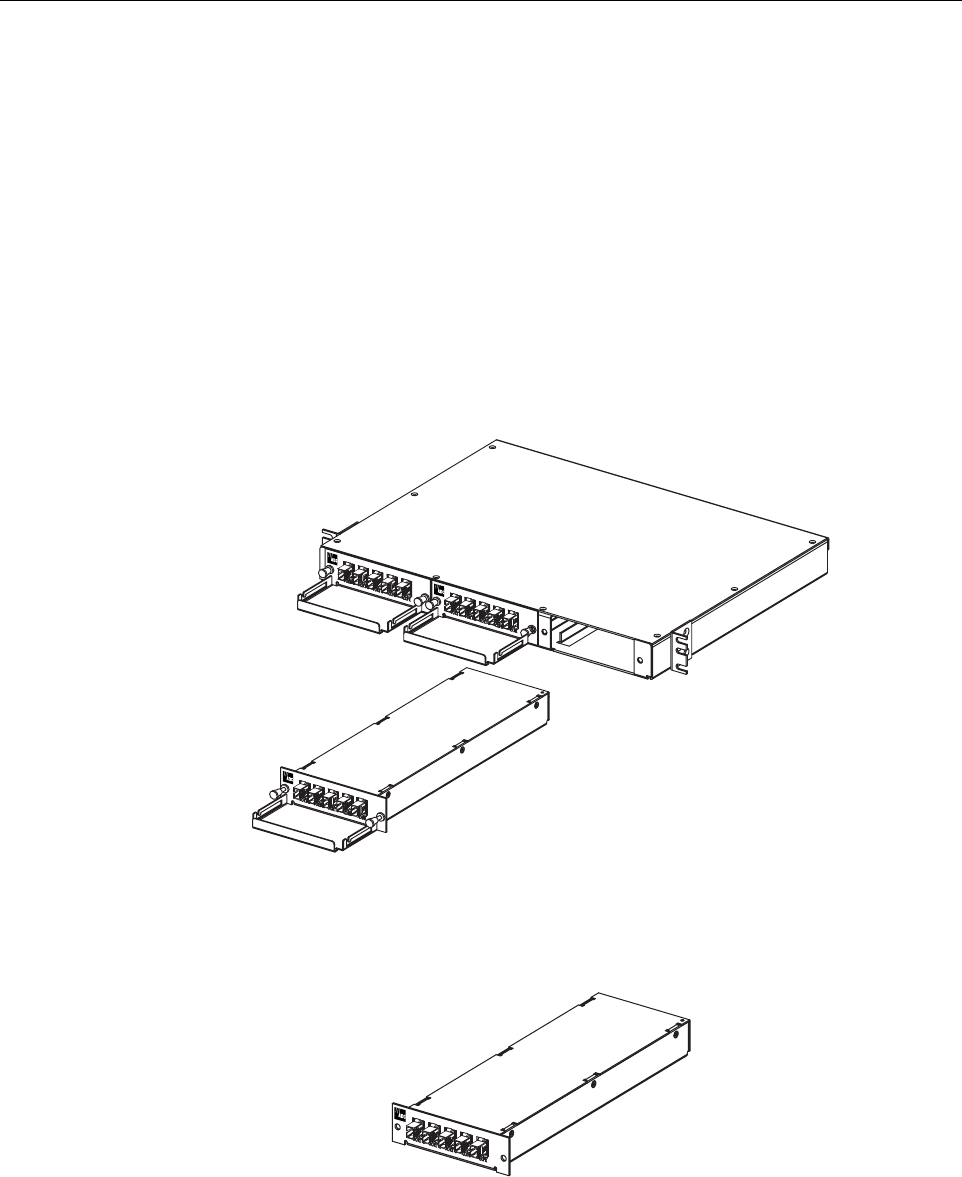
ADCP-75-159 • Issue 1 • August 2003 • Section 2: Description
Page 2-24
© 2003, ADC Telecommunications, Inc.
9 COARSE WAVELENGTH DIVISION MULTIPLEXER SYSTEM (ACCESSORY)
The Coarse Wavelength Division Multiplexer (CWDM) system is an accessory product that is
used when it is desirable or necessary to combine the forward and reserve path optical signals
for up to four Digivance systems onto a single optical fiber. Each CWDM system consists of a
Host Module, Host Module mounting shelf, and Remote Module. The CWDM Host Module
mounting shelf can support up to three CWDM Host Modules. Both the RU outdoor cabinet and
indoor mounting shelf provide a mounting slot for installing a CWDM Remote Module.
The CWDM Host Module and Host Module Mounting Shelf are shown in Figure 2-14. The
CWDM Remote Module is shown in Figure 2-15. For complete information about the CWDM
system, refer to the Digivance System Coarse Wavelength Division Multiplexer User Manual
(ADCP-75-142).
Figure 2-14. CWDM Host Module and Host Module Mounting Shelf
Figure 2-15. CWDM Remote Module
18647-A
18648-A
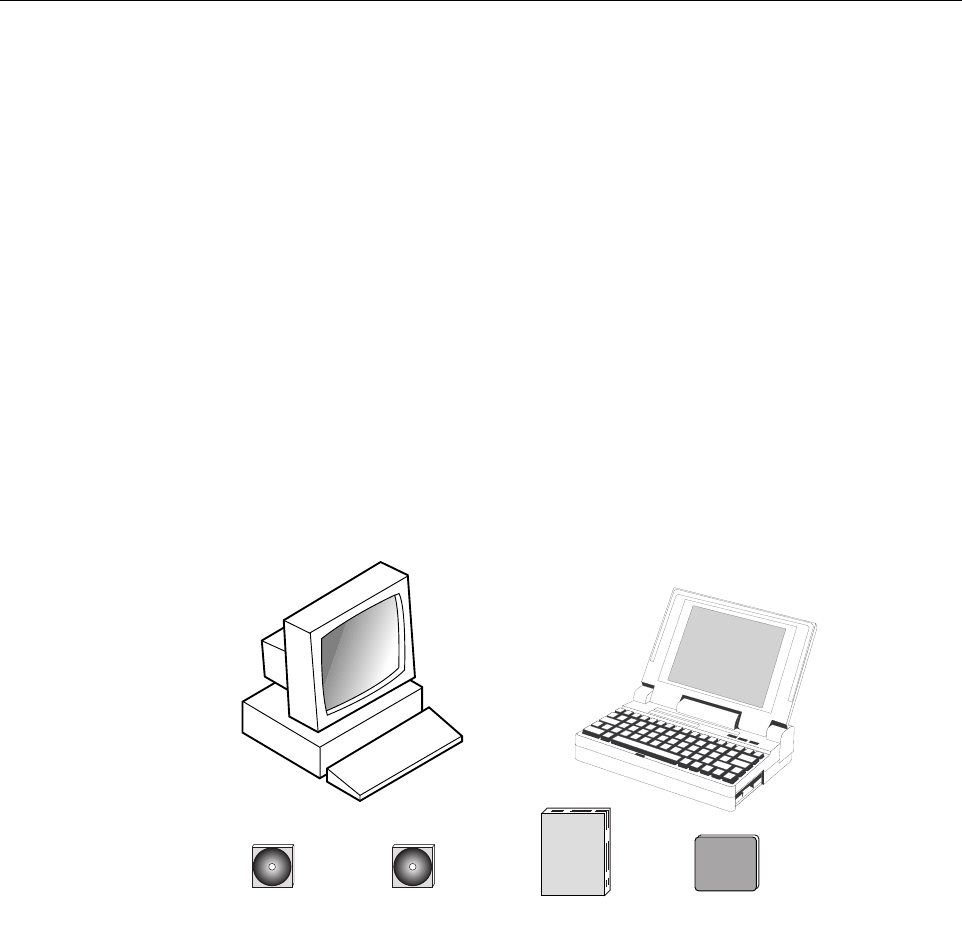
ADCP-75-159 • Issue 1 • August 2003 • Section 2: Description
Page 2-25
© 2003, ADC Telecommunications, Inc.
10 DIGIVANCE ELEMENT MANAGEMENT SYSTEM
The Digivance Element Management System (EMS) is a network management tool that provides
control and monitoring functions for the Digivance system. The EMS is used to provision and
configure new systems for operation, set system operating parameters, get system alarm and
status messages, and upgrade the system software. The EMS supports both local control by an
on-site service technician and remote control by a Network Operations Center (NOC).
10.1 Primary Components
The EMS, shown in Figure 2-16, consists of a PC-type desk-top computer (not provided) that is
loaded with the EMS software. The EMS software is stored on a CD-ROM that is shipped
separately along with a User Manual and mouse pad. The EMS software must be installed on
the EMS computer along with the Java 2 Version 1.3.1 Runtime Environment software which is
also provided. Installation consists of inserting the CD-ROM into the computer’s CD-ROM
drive and then running the software install programs. This places the Java 2 Runtime
Environment and EMS software files in assigned folders on the computer’s hard drive.
Figure 2-16. Digivance Element Management System
The EMS software may also be installed on a PC-type lap-top computer (not provided). A lap-
top version of the EMS computer can be used as a portable network management tool for
service and maintenance purposes. A laptop EMS computer can be connected temporarily to a
system to enter the initial configuration data or to trouble-shoot problems and then removed
when the task is completed. Permanent control and monitoring functions would be provided by
the desk-top EMS computer.
10.2 Service Interface Connection
The service interface connection between the EMS computer and the HU or RU requires that
the EMS computer be equipped with a DB-9 connector that is configured to provide an RS-232
EMS CD-ROM MANUALS CD-ROM
OR
NOTE: COMPUTER
NOT PROVIDED
16803-C
USER MANUAL MOUSE PAD
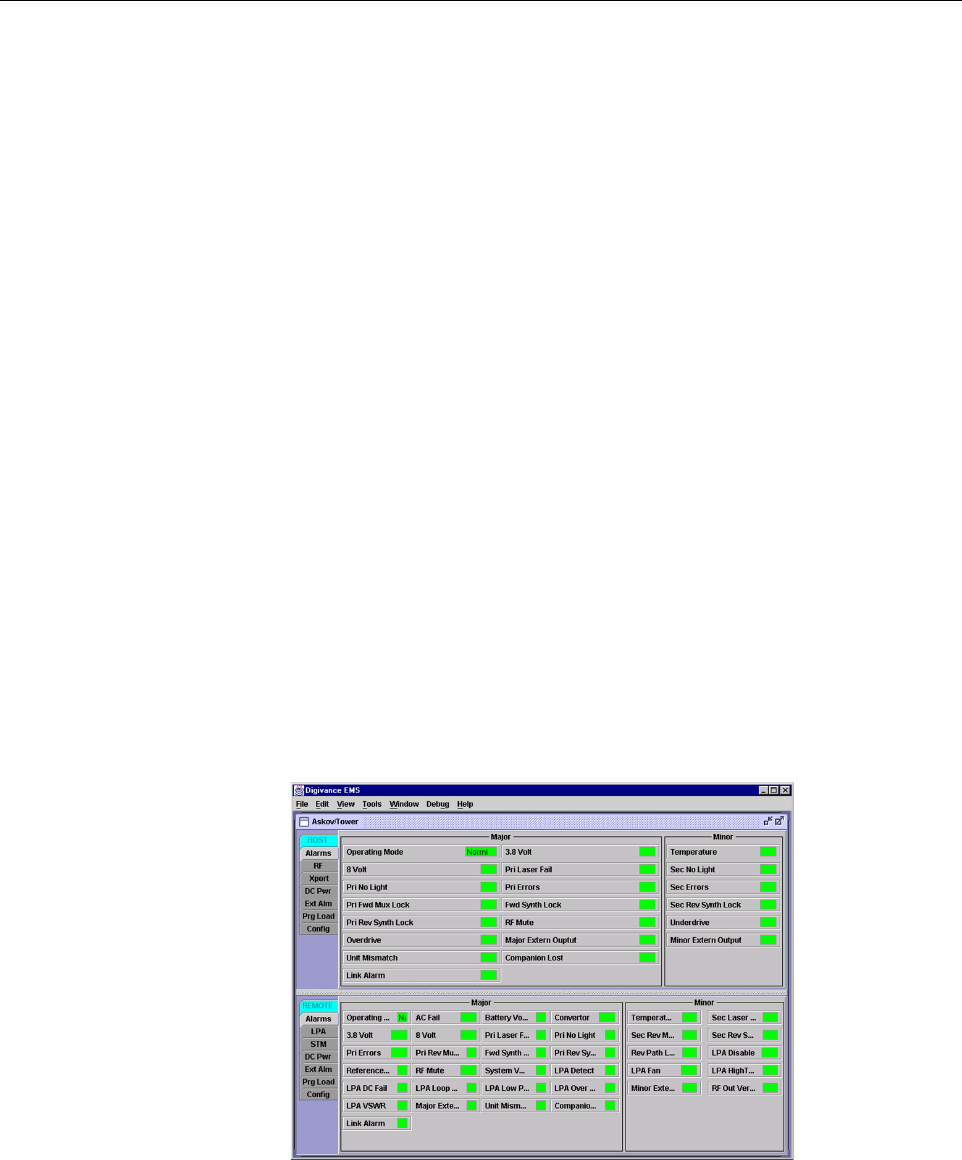
ADCP-75-159 • Issue 1 • August 2003 • Section 2: Description
Page 2-26
© 2003, ADC Telecommunications, Inc.
DCE interface. A straight-through RS-232 interface cable (accessory item) equipped with a
male DB-9 connector on one end and a PC-compatible connector on the other end is required to
link the EMS computer to the HU. When multiple HUs are networked together, the EMS
computer may be connected to the service connector on any one of the networked HUs.
10.3 NOC Interface Connection
The NOC interface connection between the EMS computer and the NOC requires that the EMS
computer be equipped with a connector that is configured to provide an RS-232 ASCII
interface. The link between the EMS computer and the NOC would generally be supported by a
data network. Cables and equipment (not provided) to support the RS-232 interface connection
between the EMS computer and the data network are required.
10.4 EMS Software User Interface
The EMS software provides two user interfaces: the Graphical User Interface (GUI) and the
Network Operation Center-Network Element Manager (NOC/NEM) interface. Both interfaces
provide essentially the same functionality except only the GUI can upgrade the Digivance
system with new system software. In addition, only the NOC/NEM interface can record and
play back alarm data.
The GUI is presented at the EMS computer or on a laptop computer. The GUI is used for local
control and monitoring operations. The GUI consists of a series of displays and screens, such as
the one shown in Figure 2-17, that provide the user with alarm and status information and that
allow the user to set various operating parameters.
Figure 2-17. EMS Graphical User Interface Host/Remote Display
The NOC/NEM interface is a command line interface that is presented at an NOC terminal. The
NOC/NEM interface is used for remote control and monitoring operations. The NOC/NEM
interface consists of ASCII text strings that are input as standard SET or GET commands which